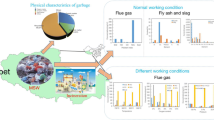Abstract
Cl is one of the main pollutants emitted from domestic waste incineration systems. In this study, we focused on the process of Ca dechlorination in the furnace of a circulating fluidized-bed waste incineration system. We analyzed the stability of CaCl2 and Ca in the furnace, the dechlorination process, and distribution of Cl in the incineration system. The results show that the optimal Ca/Cl molar ratio for Ca dechlorination in the circulating fluidized-bed waste incinerator is 2:1; moreover, the dechlorination product CaCl2 was found to decompose at high temperatures (> 850 °C). At temperatures > 700 °C, we measured CaCl2 decomposition rates up to 80%. Ca was added in the furnace, mainly to provide a dechlorination Ca source for the decomposition of limestone into tail flue gas. The amount of Ca2+ in the flue decreased gradually, parallelly to the temperature of the flue gas. Stable CaCl2 was formed after HCl was captured, and relatively small solid particles appeared in the ash collecting bag.






Similar content being viewed by others
Change history
27 August 2021
A Correction to this paper has been published: https://doi.org/10.1007/s42768-021-00078-9
References
National Bureau of Statistics. 2012–2017. http://data.stats.gov.cn/easyquery.htm?cn=C01.
Liu J, Chen J. Experimental study on combustion and dechlorination of village solid waste. Contemp Chem Ind. 2011;40(4):336–9.
Yu J. Experimental study on the flue gases pollution and control in municipal solid waste incineration. Hefei: Hefei University of Technology; 2016.
Boyi W, Hongzhi S, Longxi Q, et al. Experimental study on waste combustion and fluidized bed incinerator cold model. J Eng Thermophys. 1994;15(4):453–6.
Jianlong Q. Development status of garbage incineration in china and incinerator technology comparison. Technol Innov Appl. 2017;4:122.
Congying P, Xuguang J, Na S, et al. Study on influence of HCl upon high-temperature corrosion behavior for superheater tubes. Therm Power Gener. 2004;33(9):65–8.
Sandberg J, Karlsson C, Fdhila RB. A 7-year-long measurement period investigating the correlation of corrosion, deposit and fuel in a biomass fired circulated fluidized bed boiler. Appl Energy. 2011;88(1):99–110.
Xiongping W, Dezhen C, Jiazheng W. Removal of HCl gas from refuse incinerator flue gases. Energy Technol. 2001;22(6):268–71.
Li X, Canzhong Y, Yan J, et al. Effects of chlorine on HCl and PCDD/Fs emission in a MSW incinerator. J Eng Thermophys. 2003;24(6):1047–50.
Li X, Jiang X, Zhang D, et al. Experimental study of emission of HCl on incinerating of typical municipal solid waste components. J China Coal Soc. 2004;(01):83–87.
Guo X. Study on precipitation and control of biomass burning chlorine. Huazhong: Huazhong University of Science and Technology; 2009.
Cai R, Zhang H, Zhang M, et al. Development and application of the design principle of fluidization state specification in CFB coal combustion. Fuel Process Technol. 2018;174:41–52.
Li X, Yang C, Lu S, et al. Study on determination methods for chlorine content in municipal solid waste. J Fuel Chem Technol. 2002;(6):563–8.
Tao Y, Zuo Y, Yanguo Z. Experimental study on the combustion characteristics of municipal solid waste. J Combust Sci Technol. 2002;8(6):543–7.
Shi G, Yang D. Research on hydrolysis reactions of inorganic chlorides in crude oils. Corros Protect Petrochem Ind. 2013;30(4):1–3+16.
Shuiqing L, Yong C, Weiwu L, et al. Experimental and mechanism analyses on HCl emission control during PVC combustion in fixed beds. Environ Sci. 2001;22(2):95–100.
Xiangpai L, Xuguang J, Yong C, et al. A study on inter-reciprocity of desulphurization and dechlorination during co-firing of coal and sawdust. Proc CSEE. 2004;24(5):189–93.
Author information
Authors and Affiliations
Corresponding author
Additional information
Publisher's Note
Springer Nature remains neutral with regard to jurisdictional claims in published maps and institutional affiliations.
Rights and permissions
About this article
Cite this article
Cai, Y., Ma, Z., Yan, J. et al. Dichlorination in a circulating fluidized-bed incinerator for municipal solid waste incineration system. Waste Dispos. Sustain. Energy 1, 207–212 (2019). https://doi.org/10.1007/s42768-019-00020-0
Received:
Revised:
Accepted:
Published:
Issue Date:
DOI: https://doi.org/10.1007/s42768-019-00020-0




